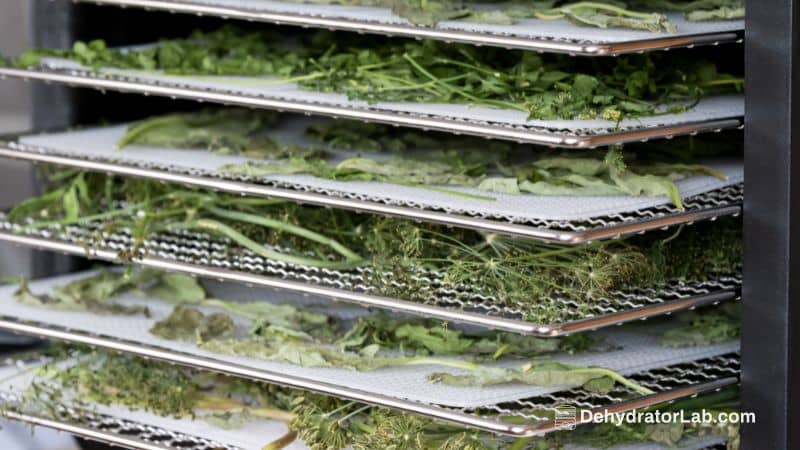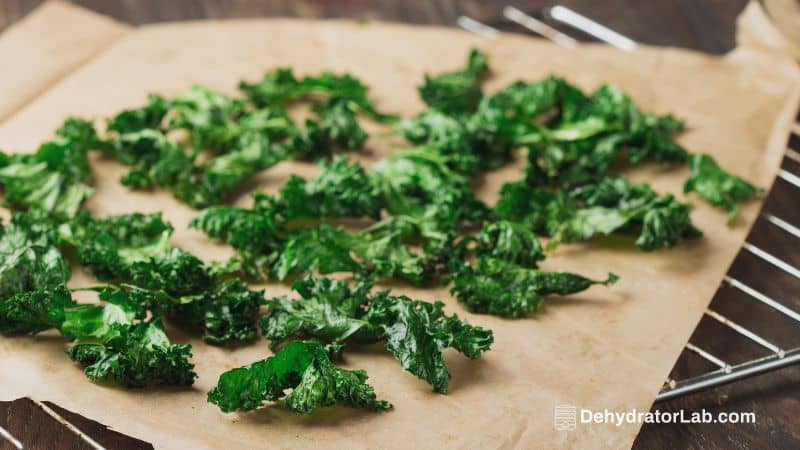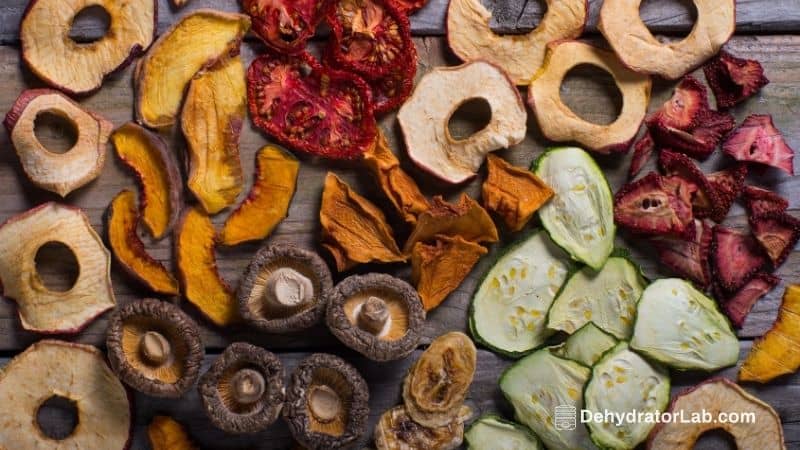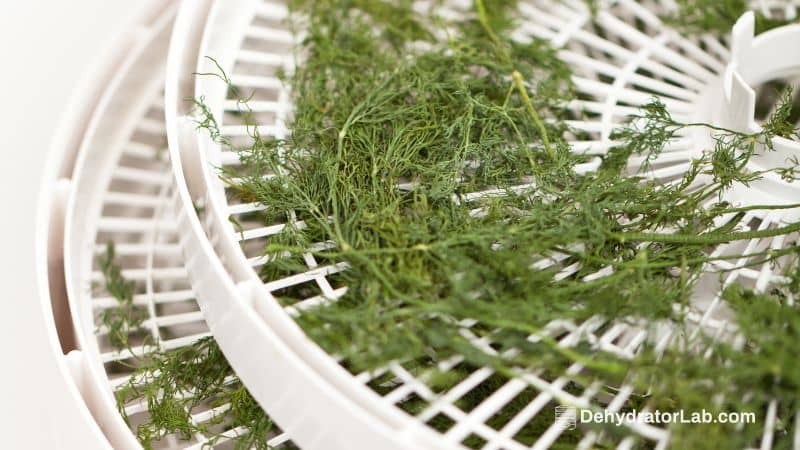Dehydrating herbs is a convenient way to preserve them for later use. A frequently asked question around this topic is whether or not to leave the stems on when dehydrating. This article aims to clarify this and provide useful tips for the dehydration process.

As an Amazon Associate, I earn from qualifying purchases. If you make a purchase after clicking on a link I may earn a small commission at no extra cost to you if items are purchased.
In this article:
TL;DR (Too Long; Didn’t Read): Key Takeaways
- 🌿 Leaving the stems on herbs when dehydrating is recommended, as even woody and thick stems can dehydrate well and be usable.
- 💡 If you have limited space or trays, you can strip the leaves off thicker and harder herbs before dehydrating them.
- 🚀 ⏳ “The leaves are going to dry a lot quicker than a lot of the stems will.”
- 💧 If the stems are not fully dry, they can be put back on the dehydrator or used directly in tea that very night.
- 🍃 However, if the stems are tender enough, like those of holy basil or basil in general, they can be included in the jar with culinary herbs for drying.
- 🌿 Leaving the stems on herbs when dehydrating allows for the possibility of using them in different ways, such as in tea blends like catnip mojito mint tea or lemon balm and orange mint tea.
- 💆 Dehydrating herbs like mojito mint and catnip allow for convenient storage and easy access to create personalized blends for various purposes, such as pain remedies or relaxation teas.
- 🌿 Leaving stems on herbs when dehydrating can be beneficial for making tea and using calming herbs for stress and anxiety relief.
To Stem or Not to Stem?
The simple answer to whether or not you should leave the stems on when dehydrating herbs is yes, you should leave the stems on when dehydrating.
Choosing the Right Herbs
It is important to know that the type of herb used can affect the outcome. Different types of herbs come with varying stem toughness. For instance, Holy Basil (also known as Tulsi) is easy to handle because its stems are relatively tender and usually dehydrate quite well, irrespective of when you pick your herbs and how woody or thick the stems are.
Consider Catnip as an example. When it starts to flower, it signifies that the stems are getting thicker and woodier. Nevertheless, as long as there’s room on the trays, the herbs, stems, and all, should go onto the trays for dehydrating.
Why Stems Are Beneficial in Dehydrating
When it comes to the actual process of dehydrating, you may be worried about space. However, the stems have an important role to play. They can help keep the leaves more separated, thereby facilitating better air circulation. This is especially true if you’re using trays where you can pile your herbs on pretty high, like the Nesco-type trays.
When you’re limited on trays or space or using an Excalibur dehydrator, you might want to strip the leaves off the thick and hard stems to save space.
Do keep in mind that not all stems will dry fully. In such cases, especially with Catnip or Mojito Mint, as long as the stems are fully dry, you can break them up along with the rest of the herbs and store them in a jar for use in teas. The stems carry many of the same benefits as the leaves and flowers.
Handling Stems That Don’t Fully Dry
The drying rate can vary between the leaves and stems, with leaves often drying quicker. If you’re in a hurry to finish dehydrating and the leaves on your stems are already dry, you can strip off the dry leaves, crush them up, and store them in a jar.
For stems that haven’t fully dried, you can either return them to the dehydrator to finish drying or use them directly in a tea.
Dealing with Woody Stems
Some herbs like Rosemary and Sage can yield very woody stems when cut way back. These parts are usually composted and not added to the dehydrating batch as they can be very hard, and they don’t break up very well.

However, if the stems are tender enough (like on your Holy Basil), you can break them up small enough and store them with your other culinary herbs.
When to Use Dried Stems in Your Teas
Dried herb stems are an often overlooked, but incredibly useful component of your herbal pantry. When it comes to tea-making, these stems can be a valuable resource.
While the leaves are the main attraction, stems hold a lot of the same benefits and can still brew up a flavorful and beneficial cup of tea. As long as the stems fully dry out, you can simply break them up along with the rest of the herbs, and add them to your tea mix.
However, the key here is to ensure that the stems are completely dry before you use or store them. Under-dried stems can be put back on the dehydrator or used directly in tea, depending on the herb.
Herbal Teas: Peppermint
Peppermint tea, whether brewed fresh or from dehydrated peppermint leaves, is a perennial favorite due to its refreshing and soothing properties.
However, diversifying your tea blends can yield interesting flavors and therapeutic effects. For instance, a blend of Lemon Balm and Orange Mint can bring a burst of citrusy freshness to your cup of tea.
Herbal Blends for Stress Relief
If stress has become a frequent visitor in your life, various herbal blends can help. My personal favorite for stressful times is a blend of Mojito Mint and Catnip. This blend makes a very calming and relaxing tea, which can be enjoyed throughout the day or in the evenings.
While I typically dehydrate my herbs separately, when it comes to this stress-relieving blend, I make an exception and mix these two for use throughout the year.
Using Stems in Culinary Herbs
Just like with teas, stems can be a valuable addition to your culinary herbs. However, this largely depends on the type of herb and the condition of the stem. Tender stems, like those found on Holy Basil or basil in general, can be broken up and added to your jar of dried culinary herbs.
However, certain herbs yield very woody stems that don’t break up well, such as Rosemary and Sage. In these instances, it’s usually best to compost these parts instead of adding them to your culinary herb mix or mixed greens blend.
Combining Dehydrated Herbs for Specific Blends
Typically, dehydrated herbs are stored separately to maintain flexibility in their use across various blends and remedies.
However, if there’s a specific blend that you frequently use, such as the aforementioned Mojito Mint and Catnip blend, it might be worth dehydrating and storing these herbs together. This could save you time and ensure that your favorite blend is always ready to go.
FAQs (Frequently Asked Questions)
Can I dehydrate herbs on the stem?
Yes, dehydrating herbs on the stem can be beneficial. The stems help keep the leaves separate and allow for better airflow during the dehydration process. Once the leaves are dry, they can be stripped from the stem and stored separately.
Can you dehydrate basil on the stem?
Absolutely! Basil, particularly Holy Basil, tends to have tender stems that dehydrate well along with the leaves. Once dehydrated, the stems and leaves can either be stored together or separately, as per your preference.
Do you dehydrate rosemary on the stem?
While rosemary can be dehydrated on the stem, keep in mind that its stems can be quite woody. After dehydrating, it may be beneficial to strip off the leaves for use and compost the hard, woody stems.
Can you dehydrate oregano on the stem?
Yes, oregano can be dehydrated on the stem. However, similar to rosemary, oregano stems can be hard and woody. You might want to remove the leaves from the stem after dehydrating.
Can the stems of dehydrated herbs be used in tea blends?
For certain herbs used in teas, like mint or catnip, as long as the stems are fully dry, you can break them up along with the leaves and use them in your tea blends. The stems contain a lot of the same benefits as the leaves and flowers.
Conclusion
In the grand scheme of things, whether or not to leave stems on when dehydrating your herbs is a small, but important detail. Remember, each herb is unique and has its own set of properties, so take the time to understand the particular characteristics of the herbs you’re working with.
Leaving stems on while dehydrating herbs is not just okay but often beneficial. So the next time you find yourself pondering over a tray of freshly cut herbs, consider this guide and make the most out of your herbs – stems and all. Happy herb dehydrating!



